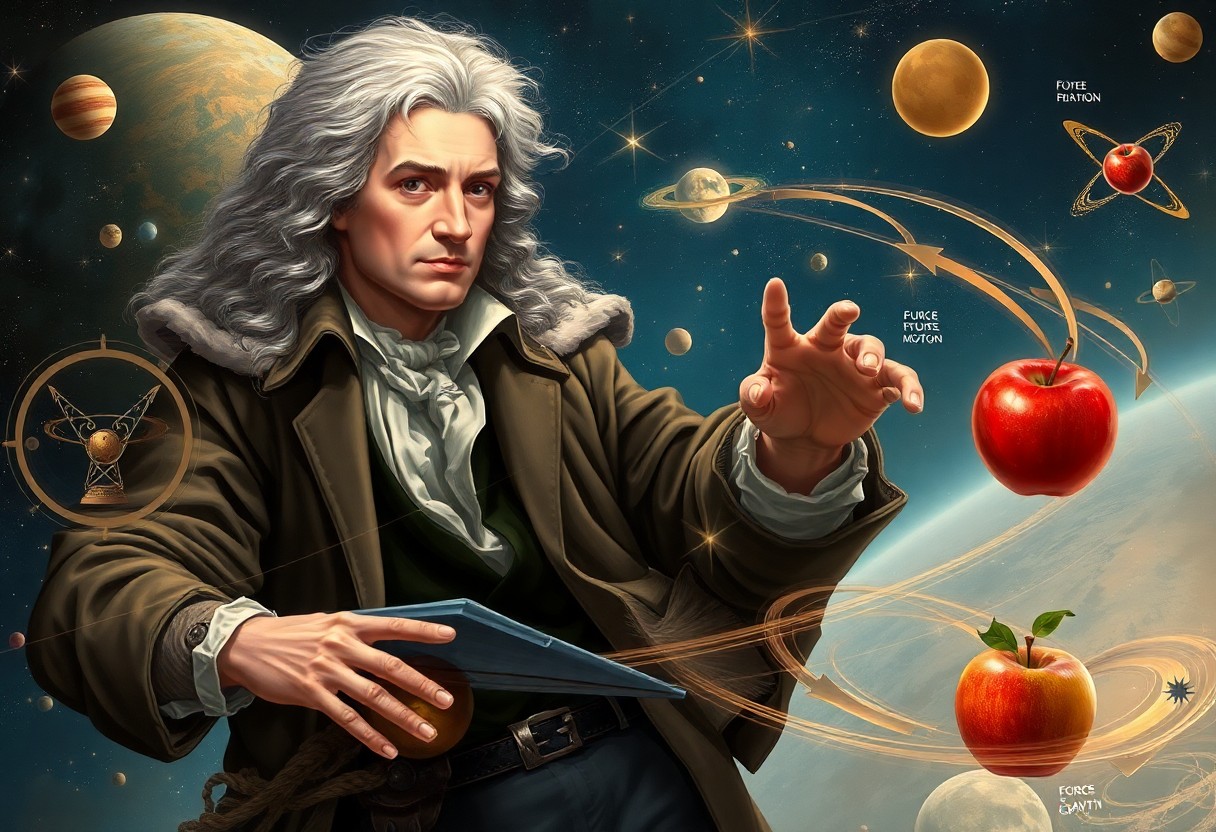With an understanding of Newton’s Laws of Motion, you unlock the foundational principles governing how objects move and interact with one another under the influence of gravity. These laws not only elucidate the predictable patterns in everyday life but also elevate your comprehension of advanced scientific concepts. By exploring these necessary steps, you will appreciate the profound impact they have had on the fields of physics and engineering, ultimately shaping our modern world and your understanding of the universe around you.
The Historical Context of Motion
To understand the development of motion theories, it’s crucial to consider the historical context that led to groundbreaking discoveries. Early civilizations struggled to comprehend the forces that governed their world, leading to various interpretations of motion and gravity. From the ancient Greeks to Renaissance thinkers, the evolution of these ideas reflects humanity’s quest for knowledge and understanding of the universe.
Ancient Philosophies
About ancient philosophies, you will find that thinkers such as Aristotle posited that motion was a result of an object being in a natural state. This view dominated scientific thought for centuries, suggesting that heavier objects fell faster and that Earth was the center of the universe. Such ideas shaped how societies understood the cosmos and influenced subsequent scientific inquiry.
Key Contributors before Newton
Ancient philosophers laid the groundwork for future discoveries, but several key figures advanced the understanding of motion long before Newton’s time. You should be aware of the contributions from individuals like Galileo Galilei, who challenged prevailing thought by demonstrating that all objects fall at the same rate regardless of mass. His experiments with inclined planes and rolling balls revealed fundamental principles of motion. Moreover, Johannes Kepler formulated laws of planetary motion that described the orbits of planets around the sun astonishingly accurately, fundamentally shifting your perception of gravity in relation to celestial bodies.
In addition, the contributions of Isaac Barrow, who developed calculus principles, and René Descartes, who introduced a new framework for understanding the mechanics of motion, were instrumental. Their work challenged traditional beliefs and paved the way for a more systematic approach to studying forces and motion. You should appreciate how these intellectual milestones formed the foundation on which Newton would build his legendary laws of motion, significantly altering your understanding of the physical world.
Newton’s First Law of Motion
Now, you will discover Newton’s First Law of Motion, often referred to as the law of inertia. This fundamental principle states that an object at rest will remain at rest, and an object in motion will continue to move at a constant velocity unless acted upon by an external force. This law forms the basis for understanding how forces influence motion in our everyday lives.
The Law of Inertia
For you to grasp the concept of inertia, it is imperative to recognize that it describes an object’s resistance to changes in its state of motion. An object will maintain its current velocity, whether at rest or in motion, unless disrupted by an external force. Thus, the greater the mass of an object, the greater its inertia, making it harder to start or stop its movement.
Implications and Examples
Implications of Newton’s First Law can be observed in various situations, such as when you abruptly stop a car, causing your body to lurch forward. This occurs because your body tends to maintain its state of motion, and the seatbelt is what acts as the external force that keeps you from continuing forward.
Understanding the implications of this law in real-life scenarios reinforces the concept of inertia. Consider how seatbelts in vehicles are designed to protect you by providing the necessary external force to counteract your body’s tendency to remain in motion during sudden stops. Similarly, when pushing a heavy object, you may recognize that the greater its mass, the more effort is needed to overcome its inertia. These examples illustrate the significant impact of Newton’s First Law on both everyday activities and safety measures, confirming the necessity of recognizing external forces in motion dynamics.
Newton’s Second Law of Motion
Assuming you apply a net force to an object, Newton’s Second Law states that the object will experience an acceleration directly proportional to that force and inversely proportional to its mass. This fundamental principle means that to understand motion, you need to grasp how force influences acceleration, emphasizing that greater forces produce greater accelerations while heavier objects require larger forces to accelerate effectively.
The Relationship Between Force and Acceleration
Acceleration is the change in velocity over time, and according to Newton’s Second Law, it results from an applied force. This relationship can be illustrated with the formula F = ma, where F represents force, m signifies mass, and a denotes acceleration. This means that for every action you take in applying a force, you should anticipate a specific reaction in terms of acceleration.
Calculating Force and Mass
Second, in your explorations of physics, you will often find yourself calculating force and mass using the equation F = ma. This equation allows you to determine the necessary force required to achieve a particular acceleration for an object of known mass. Understanding this relationship not only provides insight into motion but also reveals how manipulating force can result in significant changes in acceleration. Observing this principle in action helps you comprehend how everyday objects respond to forces, ultimately enriching your grasp of the physical world.
Newton’s Third Law of Motion
Despite the complexities of motion, Newton’s Third Law of Motion offers a simple yet powerful insight: for every action, there is an equal and opposite reaction. This fundamental principle reveals how forces interact, influencing everything from everyday activities to the mechanics of advanced technology.
Action and Reaction Explained
Third, this law emphasizes that when you exert a force on an object, that object exerts an equal force back on you in the opposite direction. For instance, pushing a wall involves your muscles applying force, while the wall pushes back equally, demonstrating the interactive nature of forces.
Real-World Applications
Beside illustrating basic physics concepts, Newton’s Third Law finds practical use in various fields, including engineering and aeronautics. Understanding the action-reaction relationship enables you to design safer vehicles and improve sports techniques by exploiting these forces to enhance performance.
The applications of Newton’s Third Law can be observed in everyday scenarios that significantly affect your life. For example, you notice how a rocket launches into space: the engines push downward with immense force, while the reaction propels the rocket upward with equal strength. Understanding this principle can lead to safer construction practices, as engineers factor in the forces acting on structures to enhance their stability and safety. Moreover, in sports, knowing how action and reaction work can help you improve your technique, potentially enhancing your performance and reducing injury.
The Law of Universal Gravitation
Not only did Newton’s Law of Universal Gravitation provide a comprehensive explanation for how objects attract one another, but it fundamentally changed your understanding of motion in the universe. This law states that every mass exerts an attractive force on every other mass, establishing the foundation for predicting the motions of celestial bodies and their interactions within the cosmos.
Formulating the Gravitational Law
Against the prevailing beliefs of his time, Newton formulated the gravitational law by observing the natural world and drawing insights from celestial mechanics. He suggested that the force of gravity is directly proportional to the product of two masses and inversely proportional to the square of the distance between their centers, thereby providing a mathematical framework for gravitational interactions.
Impact on Astronomy and Physics
Before Newton, astronomical observations were often misunderstood. His gravitational law transformed how you viewed the universe, enabling accurate predictions of planetary movements and laying groundwork for modern physics. You can appreciate how this theory revolutionized astronomy, where understanding gravitational interactions became necessary for everything from launching satellites to exploring distant galaxies.
Another significant outcome of Newton’s work was the enhanced ability to make accurate astronomical predictions and develop a rigorous understanding of orbital mechanics. The Law of Universal Gravitation not only connected earthly experiences to celestial phenomena but also revealed the forces governing tidal movements and other natural events. This shift in thinking ushered in a new era of scientific inquiry, allowing you to explore the universe in ways that were once unimaginable.
The Legacy of Newton’s Work
Your understanding of motion and gravity today rests heavily on the work of Sir Isaac Newton. His laws laid the foundation for classical mechanics, influencing not just the scientific community of his time but also shaping our modern understanding of physics. Newton’s concepts continue to inspire curiosity and innovation, making his legacy enduring in the study of the natural world.
Influence on Future Scientists
Above all, Newton’s principles have served as a guiding light for countless scientists who followed in his footsteps. Pioneers like Einstein and Galileo built upon Newton’s ideas, expanding and refining them to unravel the complexities of the universe. His work instilled a scientific rigor that encourages you to explore the underlying laws governing motion and forces.
Integration into Modern Physics
Below the surface of contemporary physics, Newton’s laws remain deeply integrated into various scientific fields. While modern theories may challenge some of his ideas, the core principles of motion continue to hold significance in our understanding of everyday phenomena.
And as you probe into modern physics, you’ll discover that Newton’s framework serves as a springboard for advanced theories like relativity and quantum mechanics. His laws of motion and universal gravitation provide a solid foundation for understanding forces at play in larger systems, including planets and galaxies. Even as we explore the limits of physics, Newton’s insights echo through time, highlighting the importance of empirical observation and mathematical description in shaping scientific thought.
Summing up
Considering all points, you can see how Newton’s Laws fundamentally altered our understanding of motion and gravity. These principles empower you to predict the behavior of objects under various conditions, enhancing your grasp of the physical world. By applying these laws, you can comprehend everyday phenomena from the fall of an apple to the orbit of planets, reinforcing the relevance of Newton’s work in both historical and modern contexts. Embracing this knowledge enriches your scientific literacy and forms a strong foundation for further exploration in physics.
FAQ
Q: What are Newton’s Laws of Motion?
A: Newton’s Laws of Motion consist of three fundamental principles that describe the relationship between the motion of an object and the forces acting on it. The first law, known as the law of inertia, states that an object at rest stays at rest, and an object in motion continues in motion with the same speed and in the same direction unless acted upon by an external force. The second law establishes that the acceleration of an object is directly proportional to the net force acting on it and inversely proportional to its mass, expressed mathematically as F=ma. The third law states that for every action, there is an equal and opposite reaction.
Q: How did Newton’s Laws of Motion alter our understanding of gravity?
A: Newton’s Laws of Motion integrated with his law of universal gravitation revolutionized the understanding of gravity. Before Newton, gravity was not well defined, and concepts of motion were often based on philosophical ideas rather than empirical evidence. Newton proposed that every particle in the universe attracts every other particle with a force that diminishes with the square of the distance between them. This provided a mathematical framework that explained not only the falling of objects on Earth but also the motion of celestial bodies, unifying terrestrial and celestial mechanics.
Q: How do Newton’s Laws apply to everyday life?
A: Newton’s Laws of Motion are evident in many everyday scenarios. For example, when driving a car, inertia explains why seatbelts are necessary—when a car stops suddenly, the person’s body will continue moving forward until the seatbelt applies a force to stop it. When throwing a ball, the second law illustrates how stronger throws result from applying more force, while lighter balls accelerate more easily. Lastly, when jumping off a diving board, the action of pushing down on the board results in an equal and opposite reaction that propels the user upward.
Q: What historical impact did Newton’s work have on science?
A: Newton’s formulation of his laws significantly advanced scientific thought and the development of classical physics. His work laid the groundwork for subsequent scientists and thinkers, leading to revolutions in various fields, including engineering, astronomy, and even mechanics. The systematic approach Newton applied, involving mathematics, paved the way for the scientific method as a means of understanding the natural world. His influence persisted, changing how societies understand forces and motion for centuries to come.
Q: Are Newton’s Laws applicable in modern physics?
A: While Newton’s Laws are foundational and accurate for many everyday situations, they have limitations at very high speeds or in strong gravitational fields. In such cases, Einstein’s theory of relativity provides a more precise description of gravity and motion. However, Newton’s Laws remain highly relevant and are extensively used in fields such as engineering, aerospace, and robotics due to their simplicity and effectiveness for most practical applications.
source link eu news
















